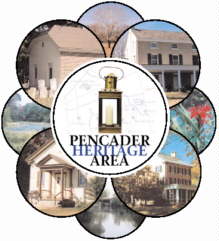| Poet Townsend had the color of the red earth correct, but the mischief on Iron Hill was not caused by the Swedes, but by the Minquas Indians. Three Englishmen and a Dutchman were murdered there in 1661 while on their way from New Amstel (now New Castle) to the head of the Chesapeake Bay. As the Minquas and the Sinnecus (Senneca) Indians were at war with each other in that area, efforts to punish
the responsible party were unsuccessful. Perhaps the site was so remote from any settled village that peace with the Indians was considered more important than atoning for the lives of a few travelers. The names of the four souls who lost their lives on Iron Hill remain a mystery but the list of those who lost their money trying to make a profit from mining the ore is lengthy.
Sir William Keith, Governor of Pennsylvania and the three lower counties, New Castle, Kent and Sussex from 1717 to 1726, wrote to
the Board of Trade in London that he had found, 'great plenty of iron ore in Pennsylvania.' A 1734 publication mentions 'smelting
works on the Christiana River, built by Sir William Keith...which produced large quantities of iron in the first two years of their existence
but were abandoned the next year owing to the difficulty of smelting the ore.'
This scenario was repeated over and over again as one buyer after another purchased the land, discovered the quality of the iron was
poor after overinvesting in the operation, and lost it in a sheriff's sale. Indeed, the sheriff must have grown weary of selling and reselling the same ground. There is even record of a sale of land which was 'salted' by bringing in good ore from another location in order to convince the buyer that he should act quickly before someone else purchased it.
J. P. Whitaker, owner of Principio Furnace in Cecil County, Maryland was the last of a long line of owners to mine Iron Hill, ceasing operations in 1884 when the ore ran out. On nearby Chestnut Hill William McConaughey followed suit from 1873 to 1884. The ore was originally formed when the igneous rock which makes up the hills, called gabbro, released iron through the weathering process. This iron combined with air and water and was deposited through seepage into the unaltered gabbro below. On Iron Hill, it was deposited in three distinct beds, one on top of another, with each bed about ten feet apart. For more than one hundred years the undisturbed hill has been slowly creating more iron ore. The
acreage preserved as a county park will keep on creating; the rest of the hill is rapidly disappearing beneath new houses.
Christine, (not Christiana)
They named the river below
That wafted their jarl'ed hosanna
Almost to the Delaware's flow;
That wilful queen they knew her
Ere Latin her mind could wean,
And they kept their leal unto her
In their queenly fiord Christeen.
G.A.Townsend
|
